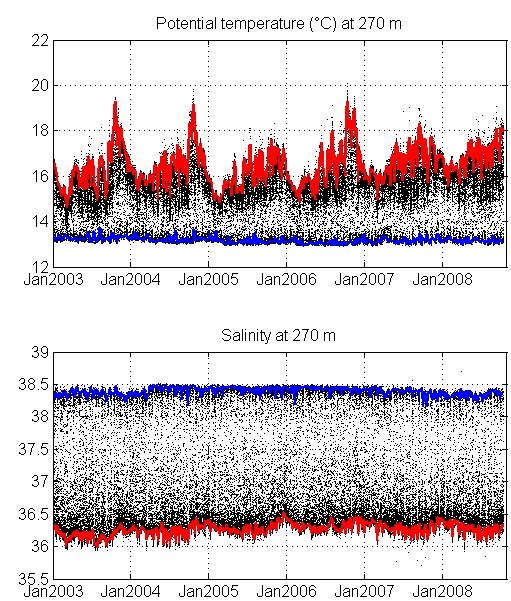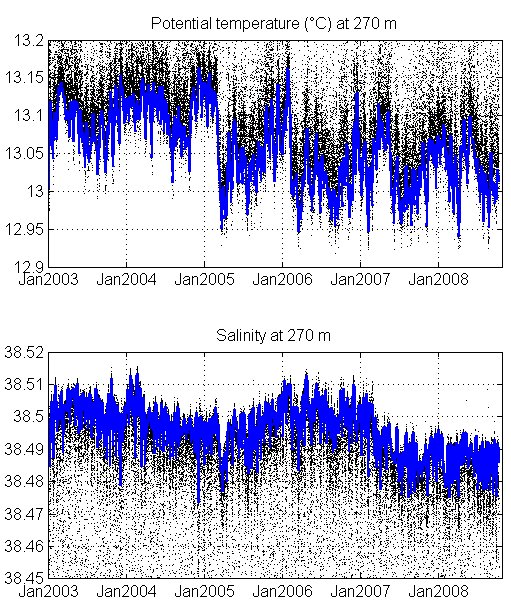 Hydrochanges Program: Gibraltar analysis (by Claude Millot) Hydrochanges Program: Gibraltar analysis (by Claude Millot)
The T-S hourly time series at Gibraltar are now almost 6 years long, as shown by Figures 1 and 2 below.
|
In the southern part of the strait, the interface between the inflowing warm fresh Atlantic Water (AW) and the outflowing cold salty Mediterranean Waters (MWs) is immersed, on average, at ~150 m. Thanks to the large amplitude of the semi-diurnal internal tide (several 10s m), and as indicated by the 80-m time series (grey points) of potential temperature (Figure 1a) and salinity (Figure 1b), both AW (red) and the MWs (blue) can be alternatively sampled (blue and red curves are inferred from the extrema values encountered during a semi-diurnal cycle). Note that all curves display a marked fortnightly variability. |

|

|
|
Figure 1 (Click on the image to get an enlarged version)
|
Figure 2 (Click on the image to get an enlarged version)
|
| AW also displays a marked seasonal variability, being relatively cool and salty in winter as a direct consequence of local air-sea interactions and mixing with the MWs. A technique that allows selecting the data characterizing AW at best (lowest influence of mixing with the MWs) indicates that the most significant data are encountered in late February (Millot, 2007). It also specifies the marked interannual variability that is obvious in both potential temperature and salinity. In particular, a huge salinity increase (0.05 /year) occurred in 2003-2007 while a temperature trend (non significant in 2003-2007) can be evidenced over the 2003-2008 period (calculated ~0.14 °C / yr). Such seasonal and interannual variations must be taken into account for any kind of long-term analysis of the Mediterranean Sea functioning. |
The MWs at 80 m mainly show an interannual variability while the technique above-mentioned also allows specifying that the relatively low salinity values encountered at the beginning of the experiment resulted in fact from a low MWs' amount, hence from MWs markedly mixed with AW. But from mid 2004 to early 2007 at least, relatively unmixed MWs were encountered at 80 m with characteristics similar to those at 270 m (Figure 3a,b; AW being never unmixed there). For both potential temperature and salinity, and in addition to the marked fortnightly variability, the noticeable feature is the absence of any seasonal variability.
Comparing the long-term variability at both 80 and 270 m (Millot, 2009, Download the file in pdf format - 3, 98 Mo) shows that the Mediterranean outflow in the deeper and southern parts of the strait mainly originated from the eastern basin of the sea till early 2005 (relatively warm and salty waters) and from the western basin then (relatively cold and fresh waters). The four major waters formed in the Mediterranean Sea can all be easily identified from such time series and CTD casts as well, which justifies dealing with a MWs outflow. Additionally, the two time series allow specifying dynamical features of the outflow, with densest MWs outflowing in the southern part of the strait (density values being sometimes larger at 80 m than at 270 m). |
|
 |
|



